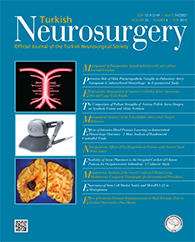Turkish Neurosurgery
2015 , Vol 25 , Num 4
Shanghai 3rd Peoples Hospital, School of Medicine, Shanghai Jiao Tong University, Department of Orthopaedics, Shanghai, China
DOI :
10.5137/1019-5149.JTN.9008-13.1
Postoperative spondylodiscitis is relatively uncommon. This complication is associated with increased cost, and long-term of inability to
work, and even morbidity. Although the majority of postoperative spondylodiscitis cases can be well managed by conservative treatment,
postoperative spondylodiscitis after internal fixation and those cases that are unresponsive to the conservative treatment present challenges
to the surgeon. Here, a review was done to analyze the treatment of postoperative spondylodiscitis with/without internal fixation. This review
article suggested that majority of postoperative spondylodiscitis without internal fixation could be cured by conservative treatment. Either
posterior or anterior debridement can be used to treat postoperative spondylodiscitis without internal fixation when conservative treatment
fails. In addition, minimally invasive debridement and drainage may also be an alternative treatment. In case of postoperative spondylodiscitis
after internal fixation, surgical treatment was required. In the cervical spine, it can be well managed by anterior debridement, removal of
internal fixation, and reconstruction of the spinal stability by using bone grafting/cage/anterior plate. Postoperative spondylodiscitis after
internal fixation is successfully managed by combined anterior debridement, fusion with posterior approach and removal of pedicle screw or
extension of pedicle screw beyond the lesion site, in the thoracic and lumbar spine.
Keywords :
Anterior debridement, Conservative treatment, Internal fixation, Posterior debridement, Spondylodiscitis, Surgery
Corresponding author : Hu Xıaop Eng, xiaopenghudoc@163.com





